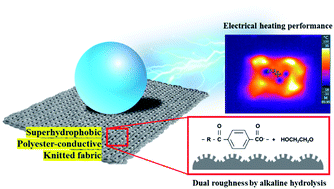Superhydrophobicity and conductivity of polyester-conductive fabrics using alkaline hydrolysis
Abstract
This study attempted to develop a superhydrophobic conductive fabric to solve the problem of functional deterioration due to oxidation of conductive fabrics. To this end, a superhydrophobic surface was achieved by introducing nano-roughness to the surface of the polyester-conductive fabric by using alkaline hydrolysis, and then lowering the surface energy through hydrophobic coating. In order to derive optimal processing conditions with excellent superhydrophobicity while maintaining conductivity and mechanical properties, changes in surface structure, conductivity, superhydrophobicity and durability of conductivity against air and water were evaluated according to alkaline hydrolysis duration. As the alkaline hydrolysis duration increased, the polyester surface was etched and the silver oxide particles formed on the conductive yarns, creating non-uniform nano-roughness. The weight, tensile strength, and strain of the conductive fabric decreased due to alkaline hydrolysis, and the change was noticeable after 30 min of alkaline hydrolysis. In addition, as the alkaline hydrolysis duration increased, the surface resistance of the conductive fabric slightly increased and the surface temperature by electric heating performance decreased, but it still showed excellent conductivity. After 30 min of alkaline hydrolysis, a contact angle of more than 150° and a shedding angle of less than 10° achieved a superhydrophobic surface. This superhydrophobic surface prevented the reaction of silver with air or water in spite of prolonged exposure to air and repeated contact with water to maintain electrical properties, thereby improving the durability of conductivity. This study is significant in that it achieved dual roughness for superhydrophobicity on the surface of conductive fabrics using a relatively easy and simple method by applying alkaline hydrolysis, which is commonly used with polyester fabric. Therefore, it is expected to solve the problem of conductivity loss of the use of conductive fabric in various environments.



 Please wait while we load your content...
Please wait while we load your content...